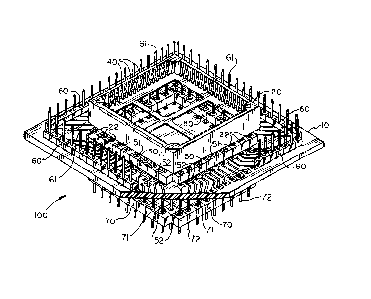Some of the information on this Web page has been provided by external sources. The Government of Canada is not responsible for the accuracy, reliability or currency of the information supplied by external sources. Users wishing to rely upon this information should consult directly with the source of the information. Content provided by external sources is not subject to official languages, privacy and accessibility requirements.
Any discrepancies in the text and image of the Claims and Abstract are due to differing posting times. Text of the Claims and Abstract are posted:
| (12) Patent: | (11) CA 1273130 |
|---|---|
| (21) Application Number: | 1273130 |
| (54) English Title: | TEST POINT ADAPTER FOR CHIP CARRIER SOCKETS |
| (54) French Title: | ADAPTATEUR DE SONDAGE POUR PRISE DE PORTE-PUCE |
| Status: | Expired and beyond the Period of Reversal |
| (51) International Patent Classification (IPC): |
|
|---|---|
| (72) Inventors : |
|
| (73) Owners : |
|
| (71) Applicants : |
|
| (74) Agent: | R. WILLIAM WRAY & ASSOCIATES |
| (74) Associate agent: | |
| (45) Issued: | 1990-08-21 |
| (22) Filed Date: | 1987-06-15 |
| Availability of licence: | N/A |
| Dedicated to the Public: | N/A |
| (25) Language of filing: | English |
| Patent Cooperation Treaty (PCT): | No |
|---|
| (30) Application Priority Data: | ||||||
|---|---|---|---|---|---|---|
|
TEST POINT ADAPTOR FOR CHIP CARRIER SOCKETS
ABSTRACT OF THE INVENTION
This arrangement provides for attaching test or probe
leads for such instruments as a logic analyzer to a leaded chip
carrier. This arrangement provides for terminating each chip
carrier lead to a metallic post upon which a logic probe or other
test apparatus may be mechanically attached to make electrical
connection. Since leaded chip carriers have their contact leads
closely spaced, this arrangement expands this distance between
leads to a suitable distance for connecting test probes. In this
manner, the semiconductor chip may be functionally tested as part
of a circuit on a printed wiring card.
Note: Claims are shown in the official language in which they were submitted.
Note: Descriptions are shown in the official language in which they were submitted.

2024-08-01:As part of the Next Generation Patents (NGP) transition, the Canadian Patents Database (CPD) now contains a more detailed Event History, which replicates the Event Log of our new back-office solution.
Please note that "Inactive:" events refers to events no longer in use in our new back-office solution.
For a clearer understanding of the status of the application/patent presented on this page, the site Disclaimer , as well as the definitions for Patent , Event History , Maintenance Fee and Payment History should be consulted.
| Description | Date |
|---|---|
| Inactive: IPC expired | 2020-01-01 |
| Inactive: IPC deactivated | 2011-07-26 |
| Inactive: IPC from MCD | 2006-03-11 |
| Time Limit for Reversal Expired | 2003-08-21 |
| Letter Sent | 2002-08-21 |
| Grant by Issuance | 1990-08-21 |
There is no abandonment history.
| Fee Type | Anniversary Year | Due Date | Paid Date |
|---|---|---|---|
| MF (category 1, 7th anniv.) - standard | 1997-08-21 | 1997-08-20 | |
| MF (category 1, 8th anniv.) - standard | 1998-08-21 | 1998-08-13 | |
| MF (category 1, 9th anniv.) - standard | 1999-08-23 | 1999-08-03 | |
| MF (category 1, 10th anniv.) - standard | 2000-08-21 | 2000-08-21 | |
| MF (category 1, 11th anniv.) - standard | 2001-08-21 | 2001-08-13 |
Note: Records showing the ownership history in alphabetical order.
| Current Owners on Record |
|---|
| GTE COMMUNICATION SYSTEMS CORPORATION |
| Past Owners on Record |
|---|
| DAVID ALAN KUTZ |
| ROBERT EDWARD RENNER |